It was 1974 when Alfons Löwenberg, a far-sighted Volkswagen engineer, levered a fuel-injected engine into his ‘Sport Golf’ side project and changed the world.
Nearly 45 years on, the benefits of marrying power and better handling to the practicality and inexpensiveness of Giorgetto Giugiaro’s timeless folded-paper design seem as obvious as combining deep-fried chips with battered fish. Yet Volkswagen took some convincing. What eventually turned the car from cottage industry to industry changer was not just its snowballing popularity, but also the fact that the value-added desirability, spun into the car’s structure like thread in the tartan upholstery, could be used to liberally fatten the family hatchback’s slim profit margin. Cracking that formula was the GTI’s lasting lesson – one that the market has applied ruthlessly and rigorously everywhere ever since.
Which lands us somewhat messily at the idea of the modern fast wagon, the illegitimate offspring of the hot hatch, the super-saloon and the humble estate car – and, in many ways, the logical end point of Löwenberg’s pragmatic thought process. The two-box estate car in its cooking format ought to be about as compelling as a van with windows, but apply a svelte, swooping rear three-quarter and sprinkle the same half-century-old pixie dust on the chassis and engine bay, and it becomes something else entirely.

Alas, there is no Golf GTI wagon to fill the thematic gap. It doesn’t exist because (a) VW is precious about where it puts arguably its most famous nameplate and (b) there are a number of similar products available elsewhere in the VW Group. Possibly the most similar (or at least the car that shares the same engine as the base Golf GTI), is the new Skoda Octavia vRS. Its defining characteristics? A just-updated 227bhp, a wheelbase longer than a Brexit negotiator’s to-do list and a £26,385 starting price – £1500 cheaper than VW will sell you a three-door GTI.
Of course, with a bigger budget, you could have a Golf R Estate for £35,300 – the 306bhp all-wheeldrive range-topper that needs no further introduction. But for around £1k cheaper and only 10bhp less, Seat will now do you the Golf R’s drivetrain in a Leon Cupra ST. The kicker here is that the Spanish tourer is sleeker than its sibling and comes equipped as standard with the 19in wheels and Dynamic Chassis Control you’d end up paying almost £2k more for in the Golf R.
Rounding out the four-pot variety box is the black sheep of the flock: the latest Volvo V60 Polestar. Again, the car requires an additional leap in budget: £45k would have been about right for our sliding scale and the model’s premium-end market position but sadly someone at Volvo has taken leave of their senses and slapped a £49,665 price tag on the 362bhp Polestar, so even with a turbocharger, a supercharger and trick chassis strapped on, it has it all to do in this company.

At near enough half the cost, the Skoda Octavia’s stall is set out impressively. Ostensibly, it is new for 2017. Or its headlights are, at any rate. And the infotainment. Both qualify as very mild facelift blusher although neither should be completely dismissed; the headlights because they make the car marginally uglier, the infotainment because it makes the car marginally better. Elsewhere, it is as sensible as a librarian’s brogues, and quite possibly as exciting. Of the three, it’s the frumpiest to look at. But otherwise, it practically dares you to find fault with its vast internal acreage or uncannily accurate ergonomics or 610 litres of boot space.
In many ways, switching into the Leon serves only to underline the Skoda’s strengths. You’d hardly think the three fingers of extra wheelbase length on the same MQB platform would make a difference, yet unquestionably the Cupra feels like a smaller sibling – one endowed with much the same underlying bone structure, but fractionally deficient in the nuts and bolts functionality that makes the Octavia seem so practical. That said, because the Seat’s kit list is so comprehensive, there’s no mistaking its high-grade ambience: the Alcantara trim is standard, as is the variable boot floor, which provides a level seats-down space. You’ll pay extra for both Alcantara and the variable floor in the Skoda.

It’s indicative of the Leon’s overall quality, though, that the step up into the Volvo V60’s price range is about as negligible as a dropped kerb. By and large, that’s because the Volvo’s interior is now six years old, and feels it. The infotainment screen, sunk so far back into the dashboard that it appears to be scurrying backwards from your aversion, is too small and too awkward to navigate via the tiny controls on the dash. Only the exceptionally comfortable seats now reflect the Volvo’s nominally superior status – that and the way the trim quality extends harmoniously into the boot. If only you could get more in it: alas, the V60’s practicality is famously handicapped by a lack of depth and a modest opening. Even the noticeably smaller Leon eclipses its 430-litre seats-up capacity.
Nevertheless, it doesn’t want for presence. In black, with huge 20in wheels, it looks forebodingly squat and purposeful and not a little Q-carish. Foreknowledge of the adjustable Ohlins and Haldex all-wheel drive system doesn’t hurt, nor does the idea that there’s a forced-induction tag team working to spirit all that output from a measly 2.0 litres. Its heavy-set charisma is replicated in the control weights. The Polestar’s steering is electrically powered now, but the map is very much the tuner’s own, and at low speeds, it’s reluctant to reduce the burden placed on the wrists by those 245-section tyres. Combine that with the slightly onerous size of the wheel and gearing that makes it a quarter of a turn slower than its rivals, and the V60 can seem cumbersome in places where the Octavia and Seat Leon waltz about with the submissiveness of shopping trolleys. The advantages of its overtly brawny footprint become apparent only when properly under way, those costly dampers delivering a low-riding yet staunchly compliant compromise that puts the V60 at the other end of a scale that starts with the Octavia.

Skoda, it seems, has barely wasted any time tying the vRS down. Compared with the Polestar, on standard-fit passive suspension and 18in rims, it appears to possess reams of spring travel. Only a lingering vertical stiffness signifies that enhanced handling has played a part in the car’s chassis tuning. Were the Octavia a proper hot hatch, its amiable bounding up hill and down dale might prove wearisome – but with the estate body on its back, the sympathetic settings rarely seem inappropriate. It helps that its control weights are pilfered from what must be a shared VW Group laptop – meaning that the light, lubricated feel of the pedals, gearstick and steering makes them feel like an extension of the same good sense that decided their location – and that the Octavia is physically light. Very light, in fact.
If Skoda is to be believed, the vRS enjoys the best part of a 400kg weight advantage over the V60. Even allowing for the barnacles that must now cling to the Ford-sourced decade-old EUCD platform of the V60, the difference probably isn’t that vast – but it’s plain enough in the real world to help explain why the newer Octavia can be made to lunge and heave without significant detriment, while the Volvo labours. The Leon, meanwhile, splits the difference. Or it does when ‘Comfort’ is selected from its adjustable driving modes, at any rate. The extra latitude afforded by the adaptive dampers is at the core of the Cupra’s agreeableness. Without them, the model would surely succumb to long-wave, head-nodding intransigence on the motorway or else crumble like peanut brittle every time those 19in wheels encountered a drain cover. Instead its refined brand of firm is entirely compatible with prolonged daily use.
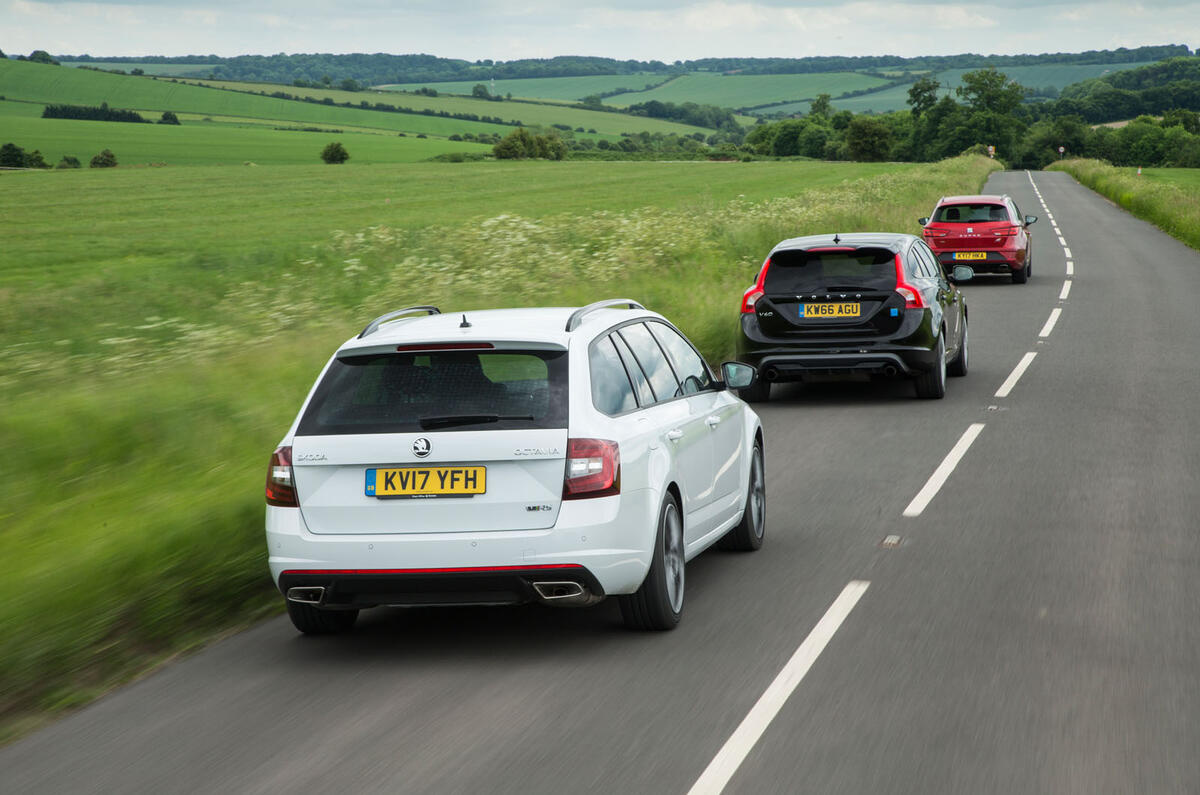
Yet it still doesn’t quite coax the same ease-of-use vibe from its driver as the Octavia. Officially, the Seat, too, is heavier, although it’s not the feeling of extra mass that gently curbs its usability but rather the duller sense of control emanating from the two-pedal drivetrain, which has none of the mechanical gloss of the manual nor any subtlety in the brake pedal. As with the estate version of the Golf R, there’s no possibility of swapping out the DSG ’box. Moreover, Leon buyers must make do with the older six-speed variant. (R buyers get an additional ratio, which makes for a leisurely attitude on motorways).
That said, in between the missing cog and a slightly over-baked stepoff, the dual-clutch transmission makes a fine foil for the EA888 engine’s higher state of tune. The unit’s throaty appeal is based on the bounty of a deeply generous midrange; custom-built for a gearbox only too happy to be left to its own devices. Middling throttle inputs tap instantly into a prominent stratum of torque, one that powers the Leon distantly away from the notion that it might be anything other than hugely brisk. Upshifts, as imperceptible as falling snowflakes, melt away convincingly in the rush – yet it is the adroitness of the downshifts that differentiate the powertrain from the V60’s conventional automatic.
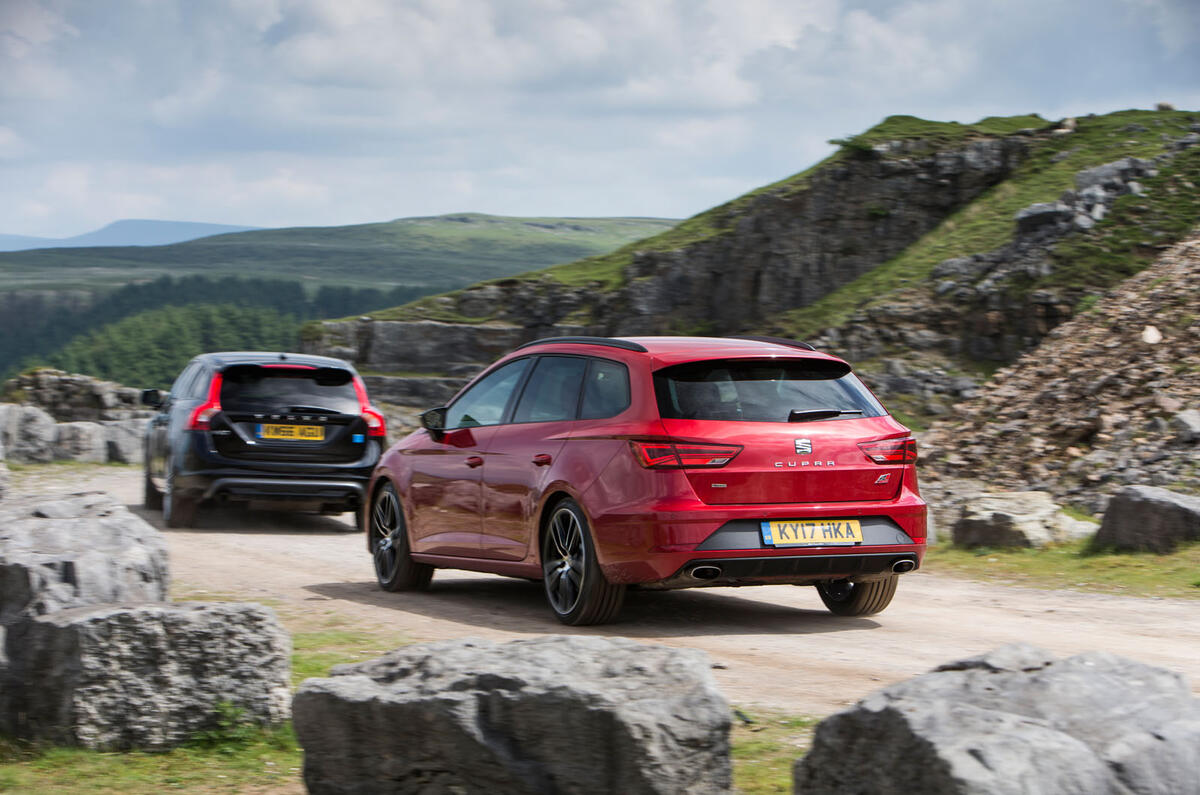
Where the Seat arguably suffers from one too few ratios, the Polestar’s eight-speed ’box has too many to choose from, and when not dallying at its preference, the kickdown seems sluggardly compared with the DSG, even in its more aggressive modes. Consequently, where the Leon’s transmission tends to complement its engine’s temperament, the Polestar’s too often seems like it’s obstructing its four-pot with a proclivity for either holding onto a gear too long or else tardily attempting to match revs for one or two cogs below. That said, with peak torque not available until 3100rpm and the best part of two tonnes to shift, blame for the V60’s lack of low-rev impetus is probably spread more evenly than it seems.
The answer to all this, of course, is to drive faster and take care of the gearshifts yourself. There’s no razor sharpness to be attained, but the manual upshifts now come in half the time, with boisterous mule-kicks as accompaniment. Unlike the Seat, which won’t let you hit the limiter even if you fluff a pull on its child-sized paddles, the V60 will strand itself at the redline without intervention. Once into its stride, the T8-derived motor – thanks to the higher-grade internal components dropped into it by Polestar – delivers a whizzy final throe, one not overburdened by the energy drag of feeding and cooling its dual air compressors.

A 135bhp deficit and none of Volvo’s whistles and bells ought to mean an early bath for the Octavia. But the vRS, possibly aided by lower expectation, rarely disappoints. Its reason for being – cultivated specifically by that mild-mannered chassis – is the ability to flick from buttoned-down worker bee to angry wasp in the time it takes to consecutively flatten the clutch and accelerator. Doing so takes about an aeon longer than pulling the paddle in either of its rivals – but properly participating in the moment, on a gearstick that’s not too long or too short or too heavy or too light, flings out the usual full-bodied reward. The wagon’s lower kerb weight and the artificial (but not unlikeable) piped-in engine gargle do the rest.
Flat out, the Octavia feels quicker than its 6.8sec 0-62mph time suggests, and in conjunction with standard wheels and Bridgestone Potenza tyres, our test car seemed admirably resistant to the axle tramp that tends to afflict fast front-drive MQB models. It proved predictably less immune, though, to the strain of being driven very quickly over undulating B-roads on Brecon, an inevitable facet of its chassis’ in-built pliancy. Lateral grip, bolstered by warm, dry tarmac, is not wanting, and neither is the sense of stability doled out by the longer wheelbase – but the body lean is pronounced compared with its rivals here and the speed carried commensurately lower.

At its most engaging, and in the fast corners that flatter it, the Polestar’s heaviness is made to feel like a satisfying component of immovable heft; kept flat by the suspension’s work rate and dependable by the 50/50 split of torque fore and aft. But lithe, adjustable, agile or inspiring are all adjectives that remain just over the horizon for the punchy V60.
Truthfully, the Leon can’t lay credible claim to all these attributes, either. It is more precise than it is rousing, faster than it is feelsome. Yet its allure is easily discernible, too. The 4Drive system makes easy work of the engine’s output, just as the output makes light work of the kerb weight. And although it obliges you dynamically only on its own terms, it does indulge the impression that you’re successfully wringing its neck.
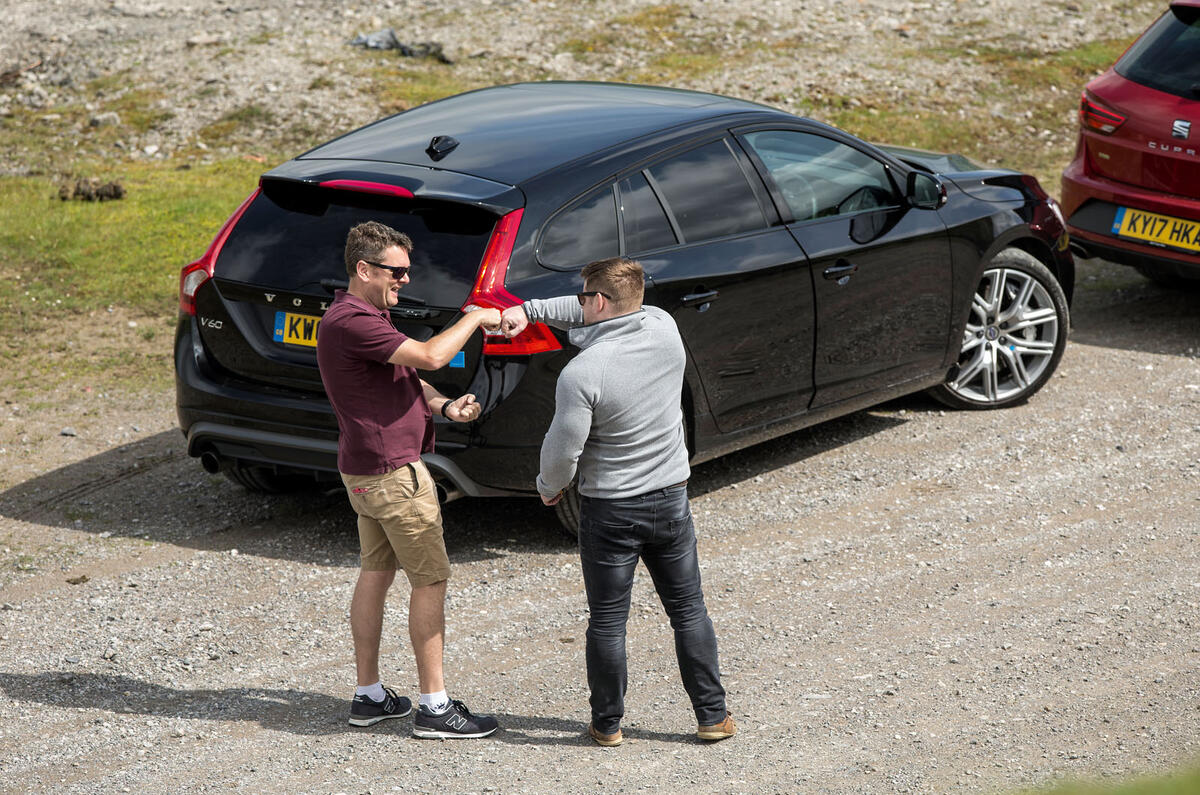
Could it be had with a manual gearbox and a trifle more pricing daylight between it and the Golf R Estate, the Cupra would likely walk this contest – and it remains a compelling choice even as it stands. Nevertheless, its mix of power and practicality doesn’t feel as irresistible as the slower, less comely and comparatively unsophisticated Skoda. That’s because, much like Löwenberg’s Sport Golf, the vRS doesn’t feel like a concept needlessly powered-up or overpriced or extreme, but instead gently ushered from contented mediocrity to enlivening modesty.
It doesn’t do fast nonchalantly or brazenly. It does it as accessible, unpretentious fun and in a way that doesn’t limit the utility or value for money at its core. People, pets and possessions, in prodigious quantities, are still shifted without fuss by the vRS: the difference is that your enjoyment and its anticipation are packaged right alongside.
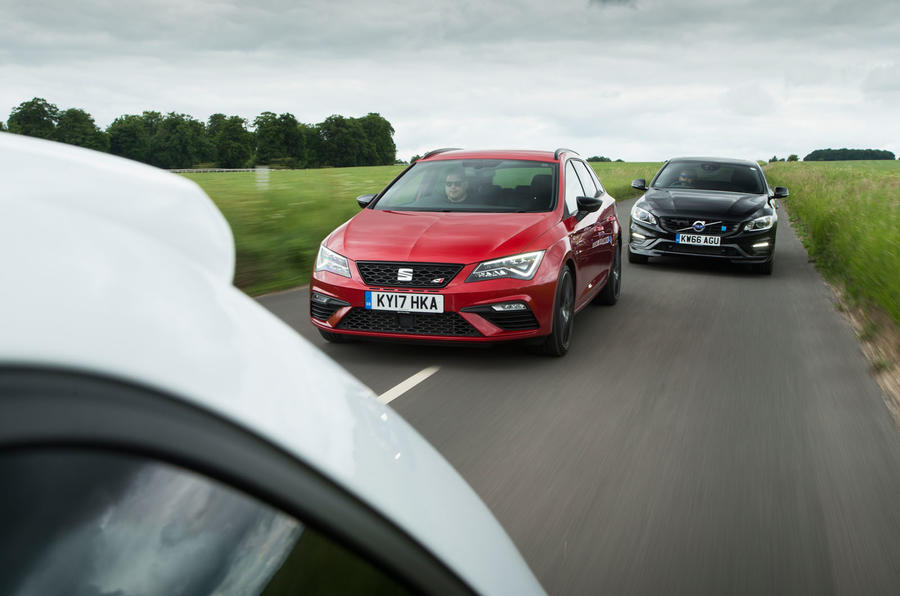
Seat Leon ST Cupra 300 4Drive DSG
Rating: 4/5, Price: £34,485, Engine: 4cyls, 1984cc, turbo, petrol, Power: 296bhp at 5500-6200rpm, Torque: 208lb ft at 1800-5500rpm, Gearbox: 6-speed dual-clutch automatic, Kerb weight: 1470kg, 0-62mph: 4.9sec, Top speed: 155mph (limited), Fuel economy: 39.2mpg (combined), CO2/tax band: 164g/km, 31%

Rating: 4.5/5, Price: £26,385, Engine: 4cyls, 1984cc, turbo, petrol, Power: 296bhp at 4700-6200rpm, Torque: 208lb ft at 1500-4500rpm, Gearbox: 6-speed manual, Kerb weight: 1367kg, 0-62mph: 6.8sec, Top speed: 153mph, Fuel economy: 43.5mpg (combined), CO2/tax band: 149g/km, 28%
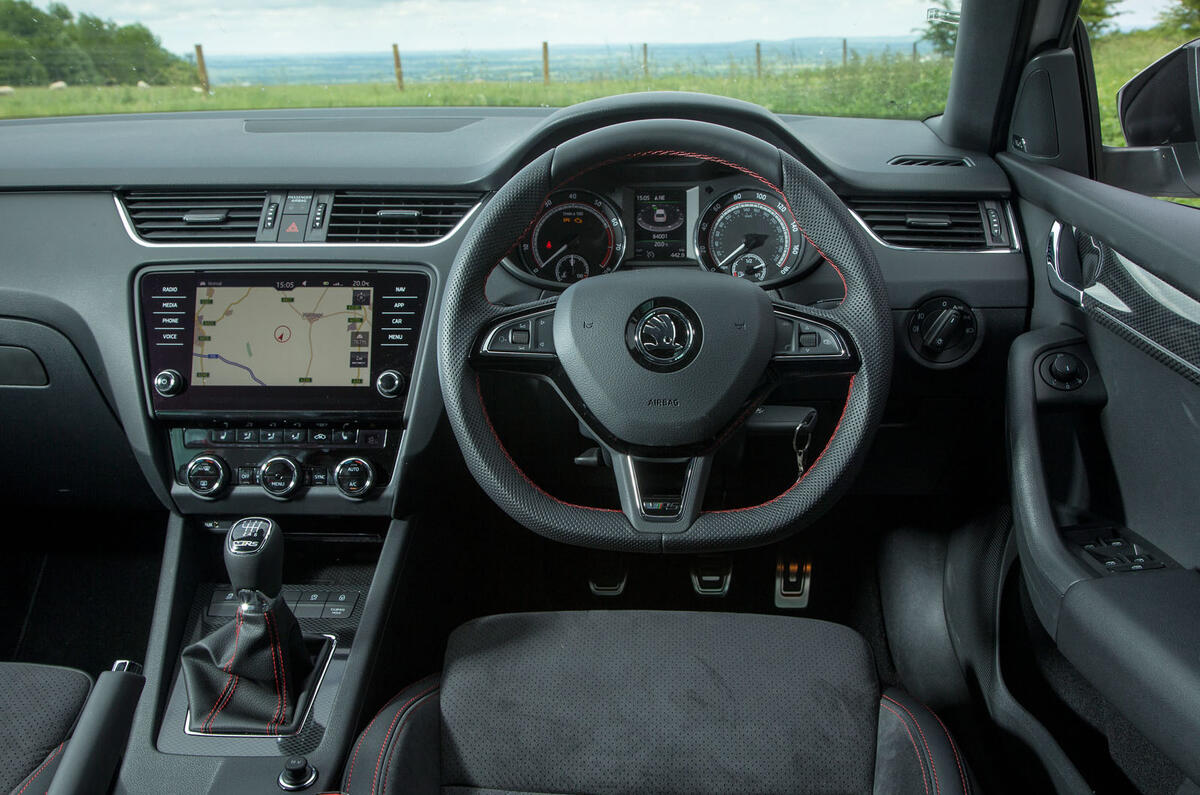
Rating: 3.5/5, Price: £49,665, Engine: 4cyls, 1969cc, turbo, supercharged, petrol, Power: 362bhpat 6000rpm, Torque: 347lb ft at 3100-5000rpm, Gearbox: 8-speed automatic, Kerb weight: 1772kg, 0-62mph: 4.8sec, Top speed: 155mph (limited), Fuel economy: 34.9mpg (combined), CO2/tax band: 186g/km, 34%


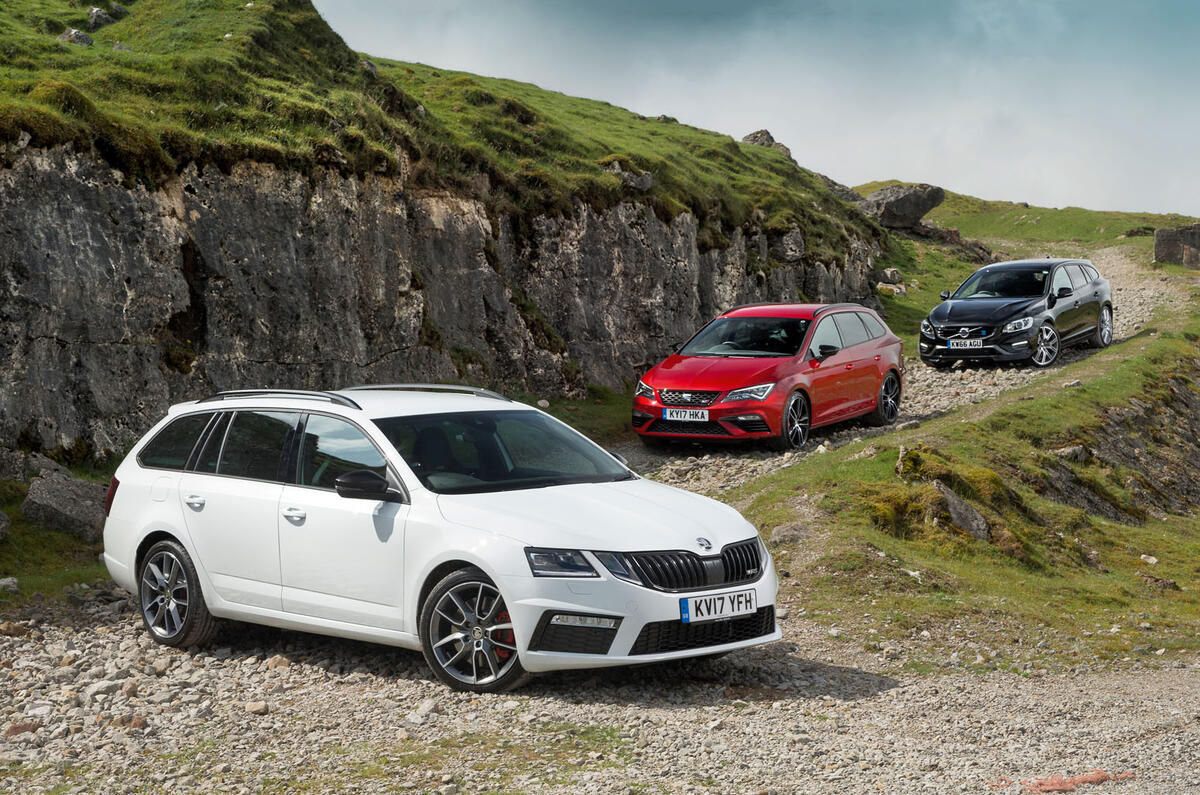
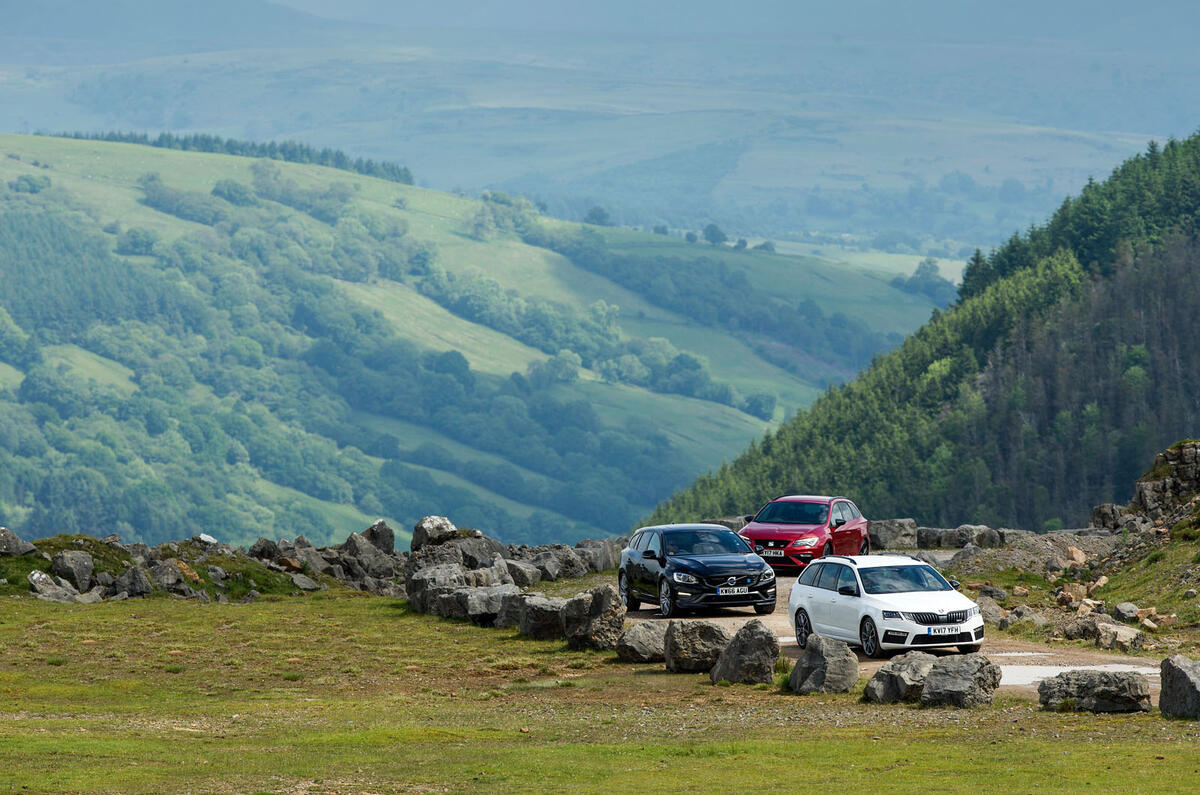
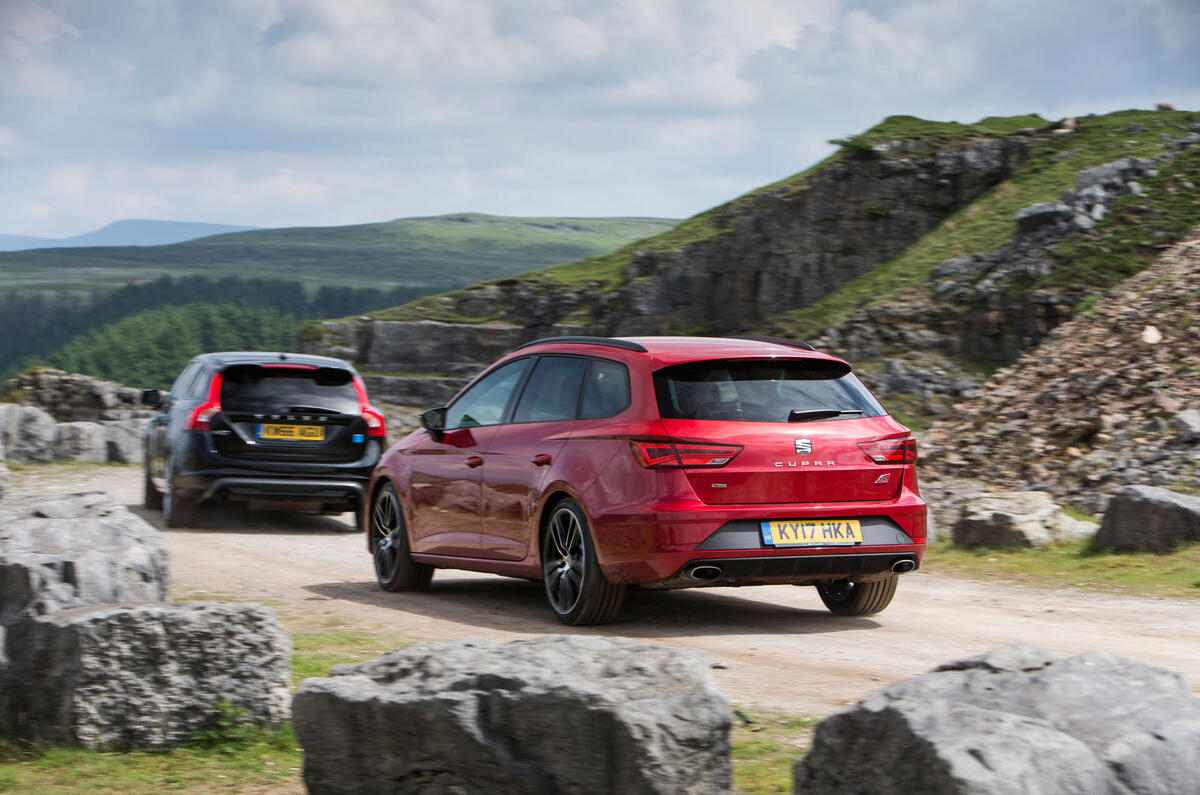
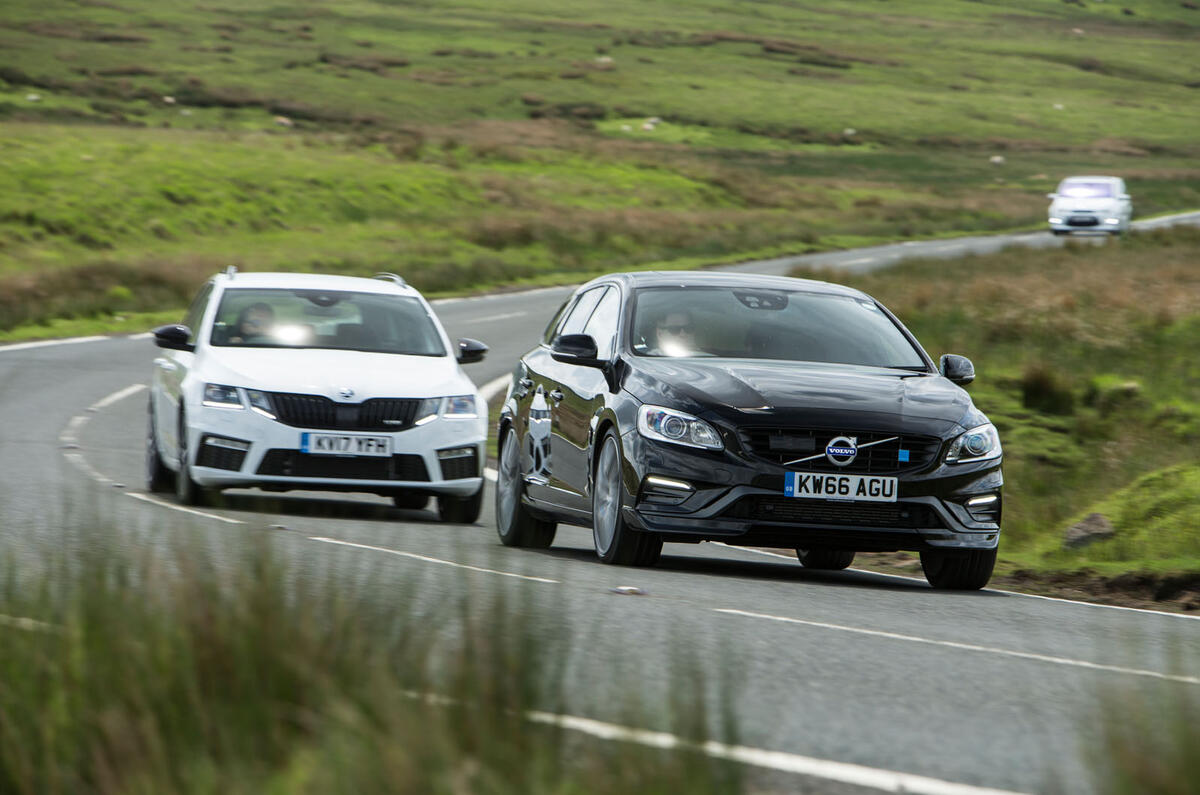
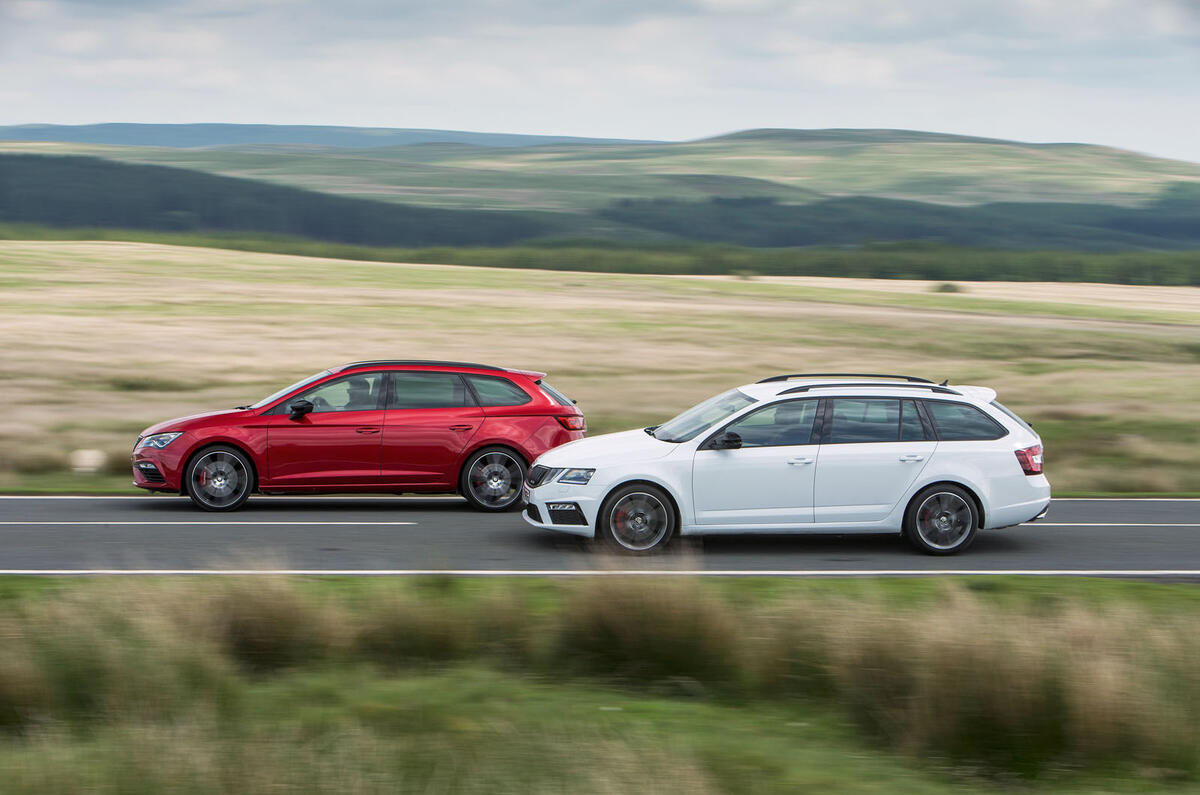
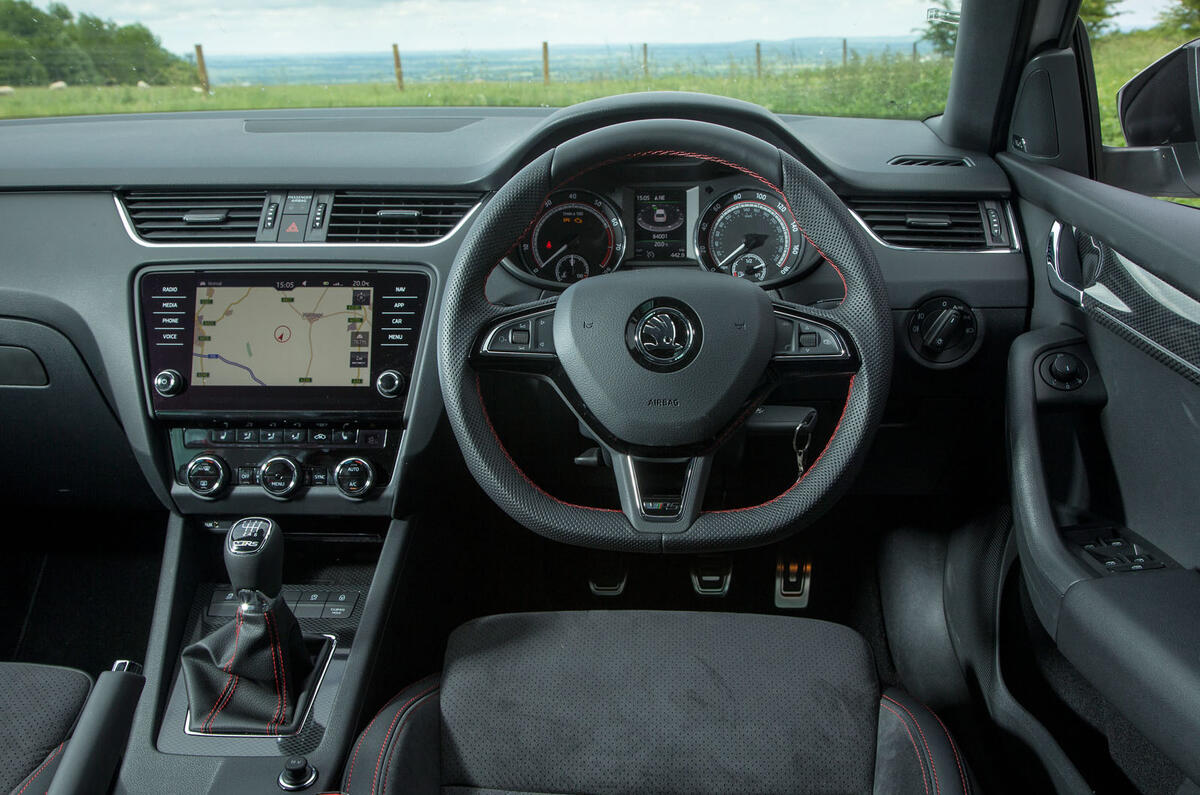
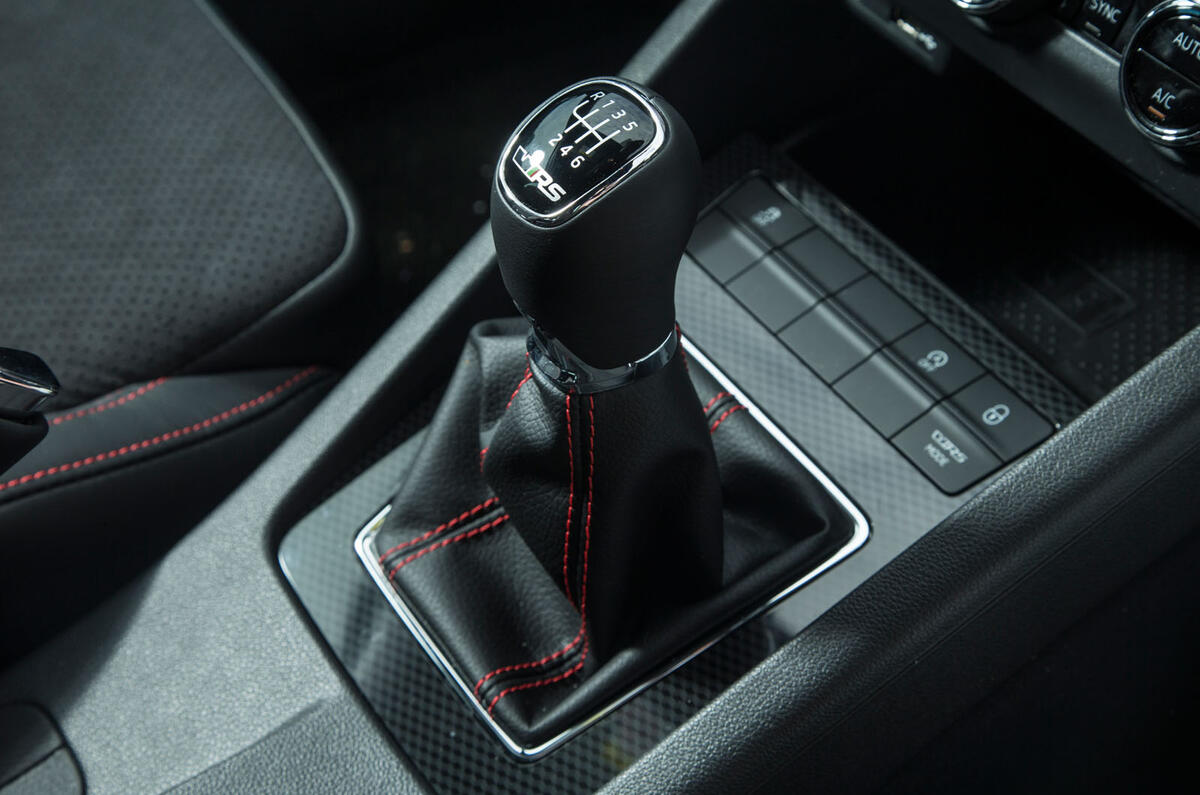

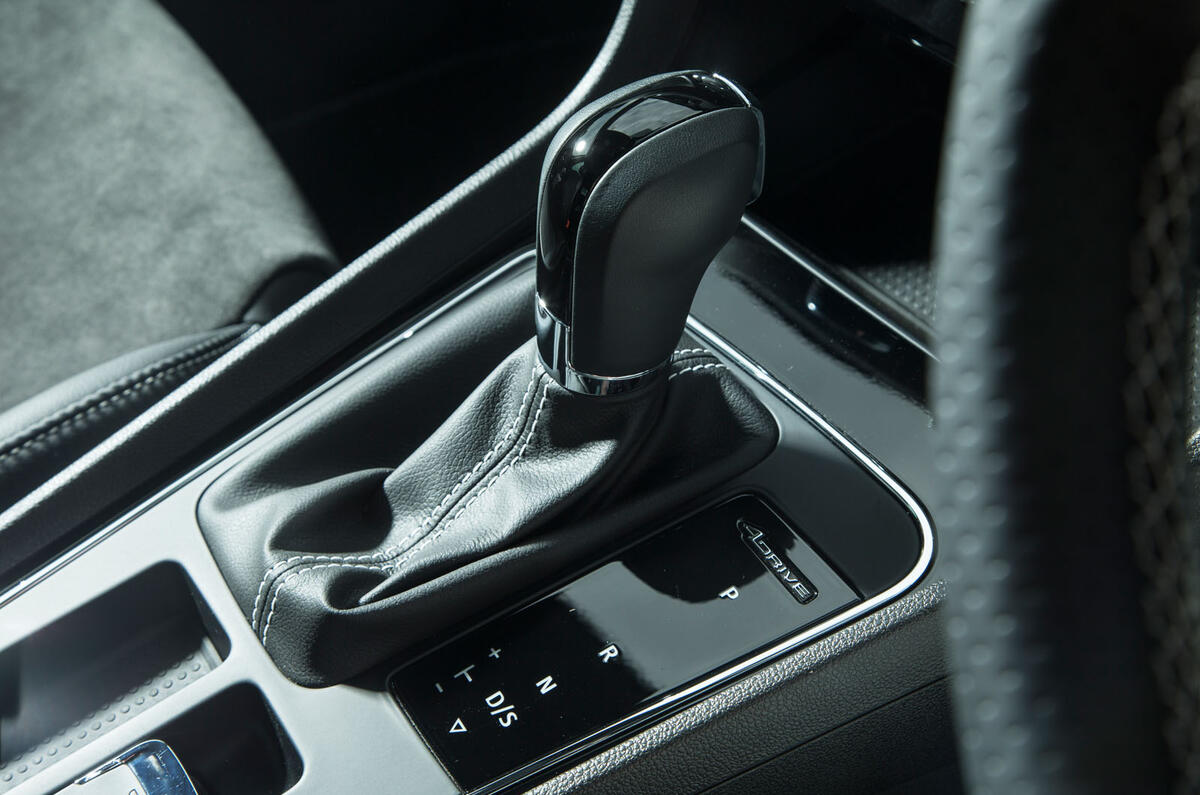
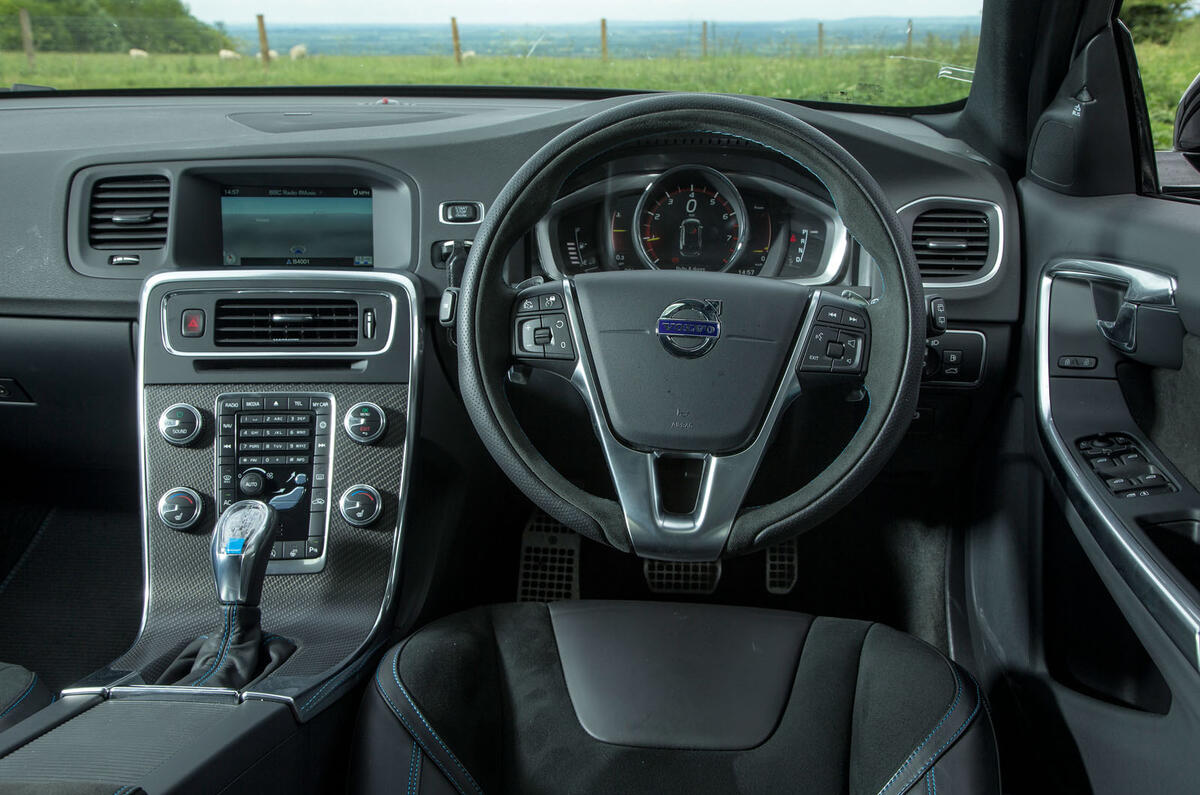
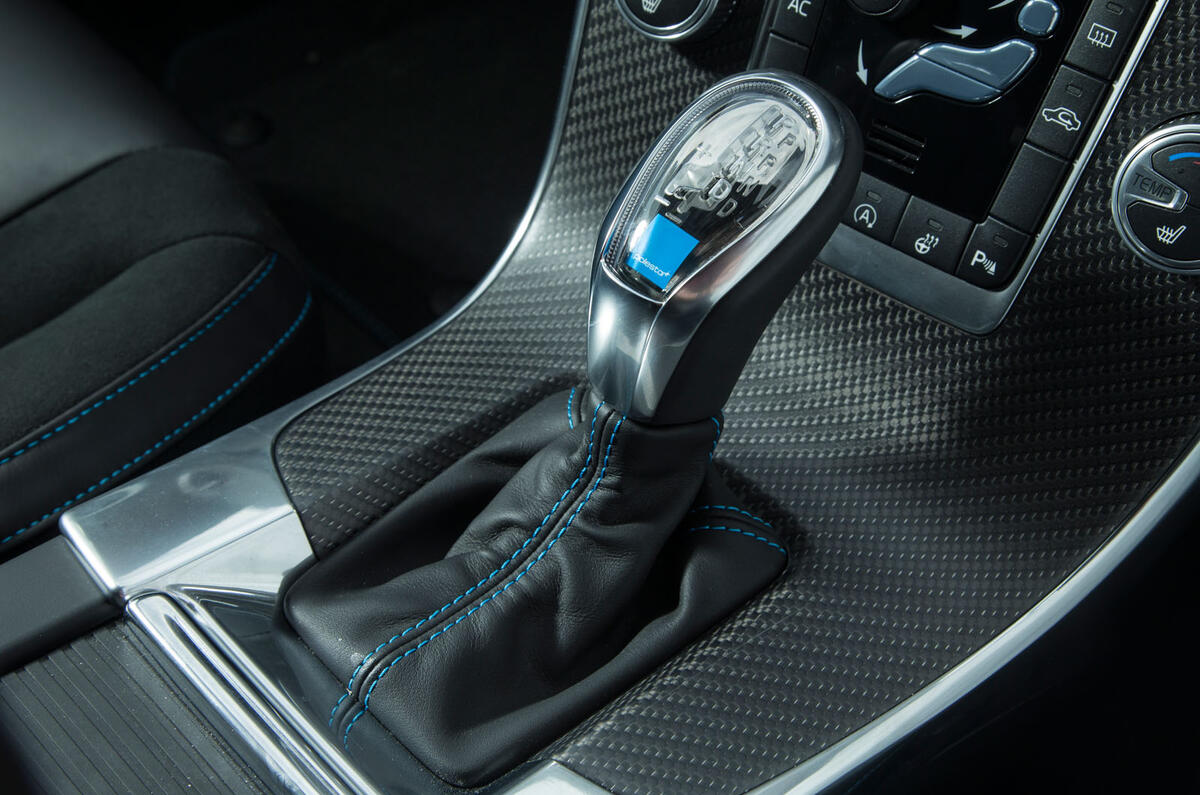


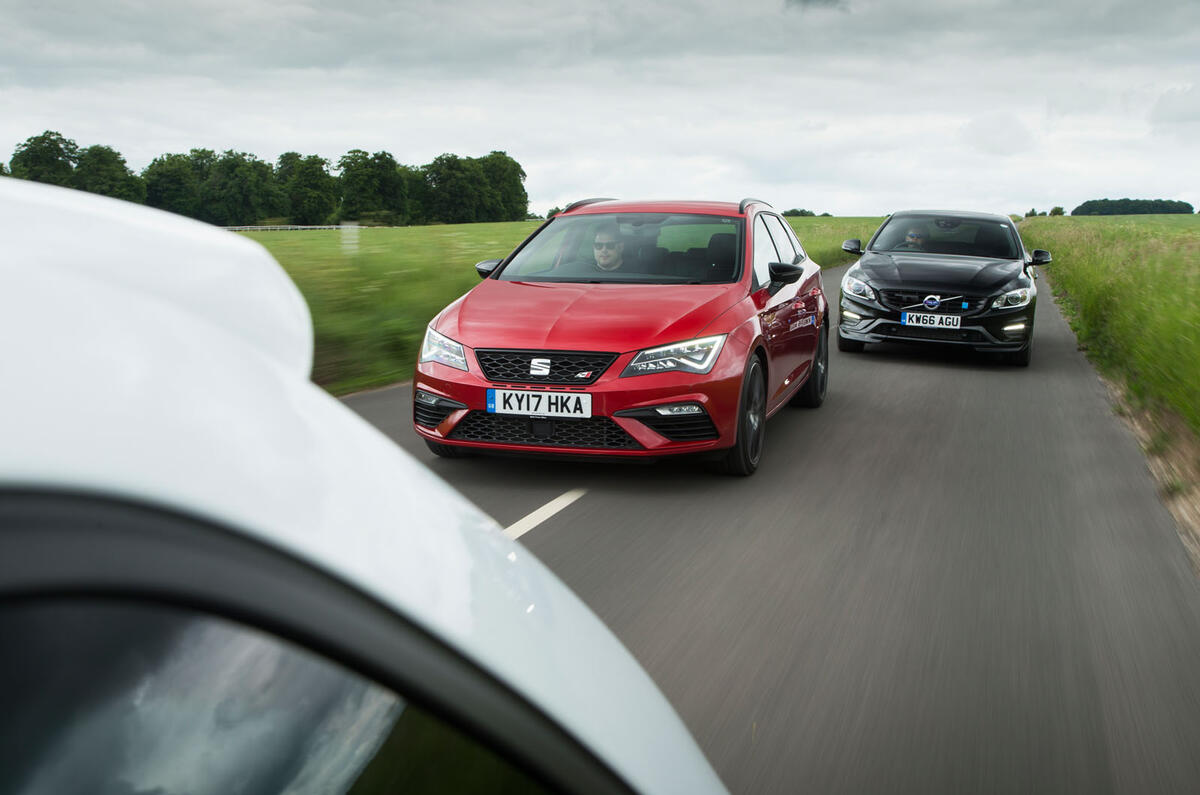
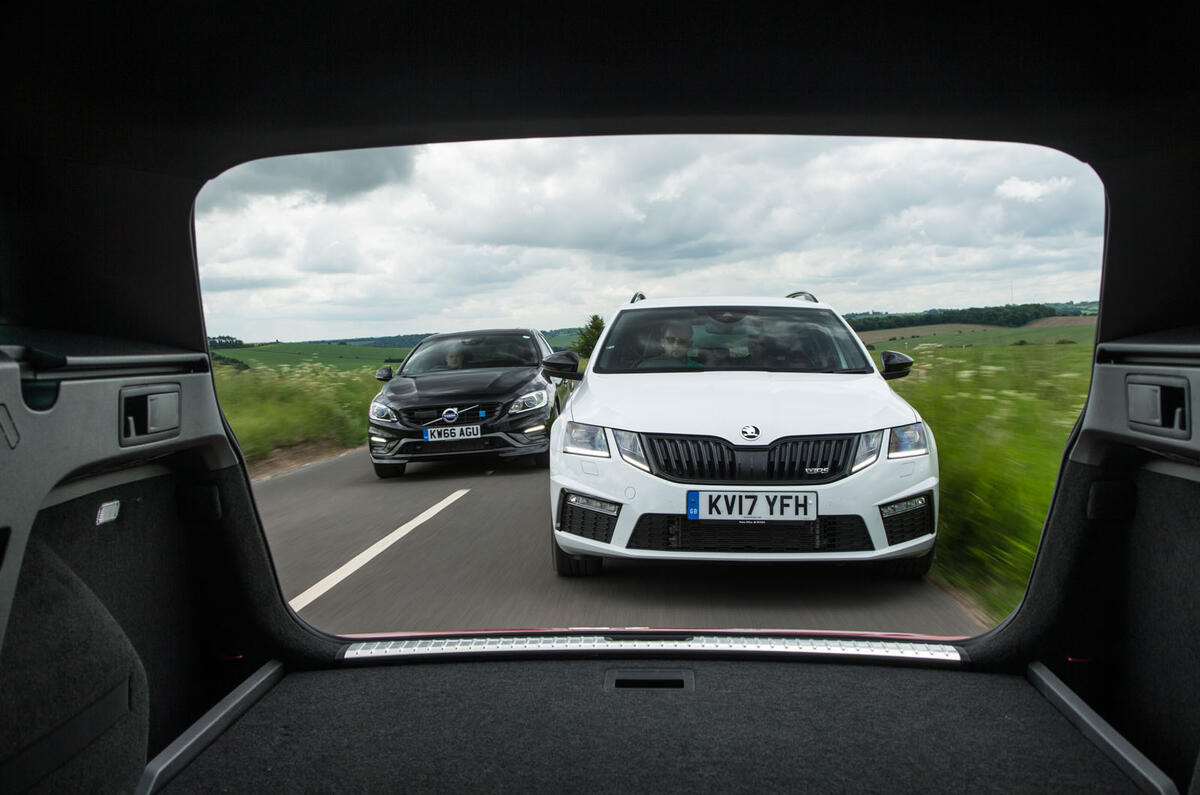
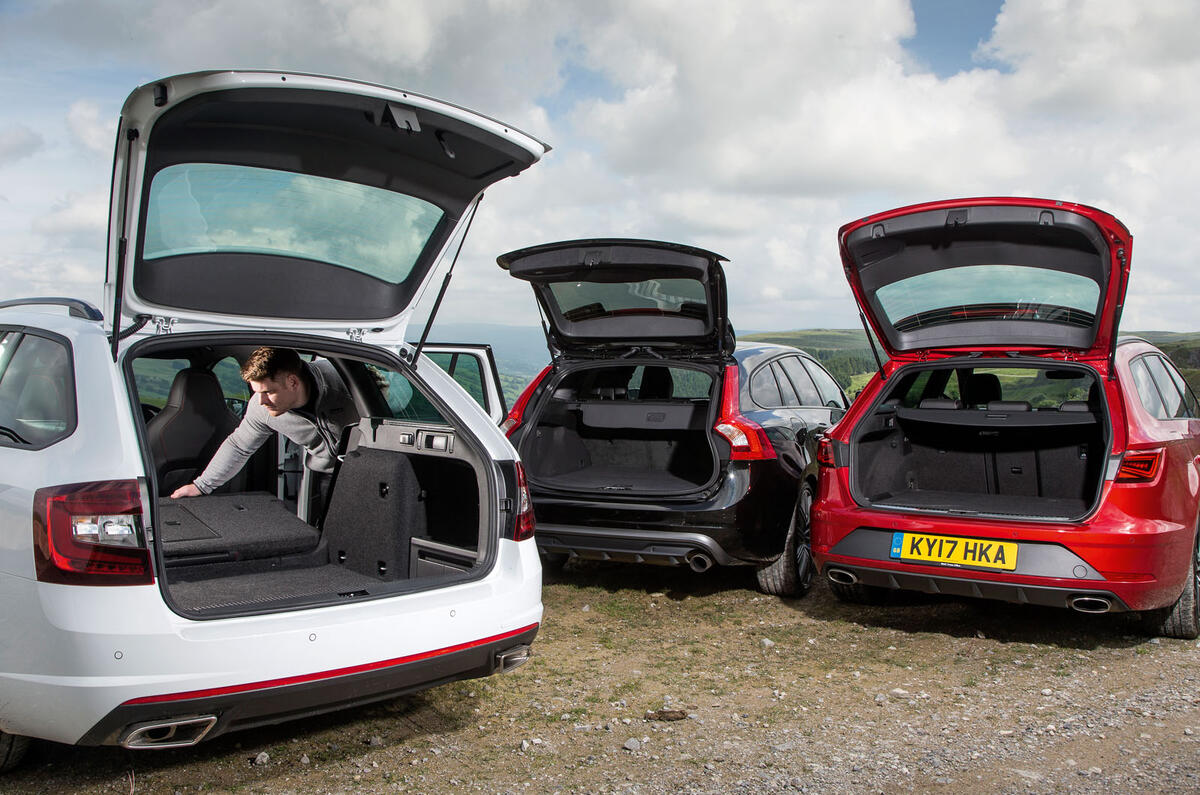
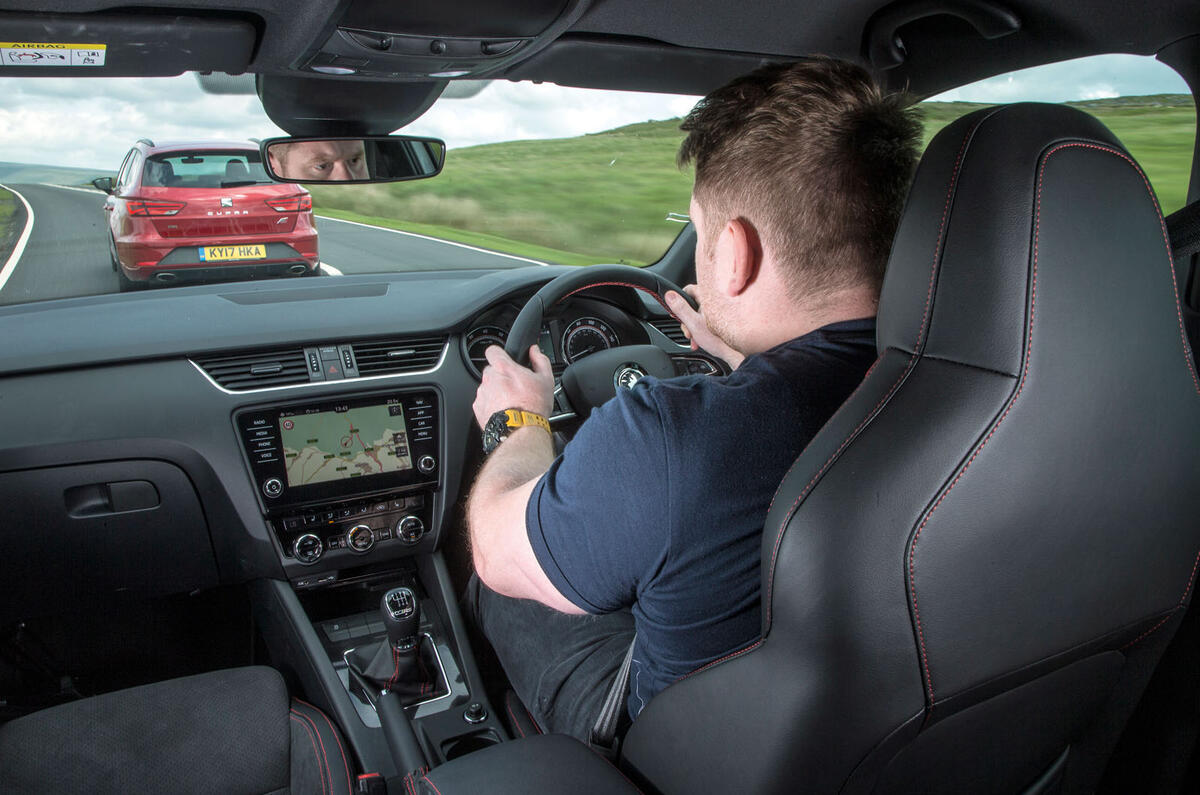
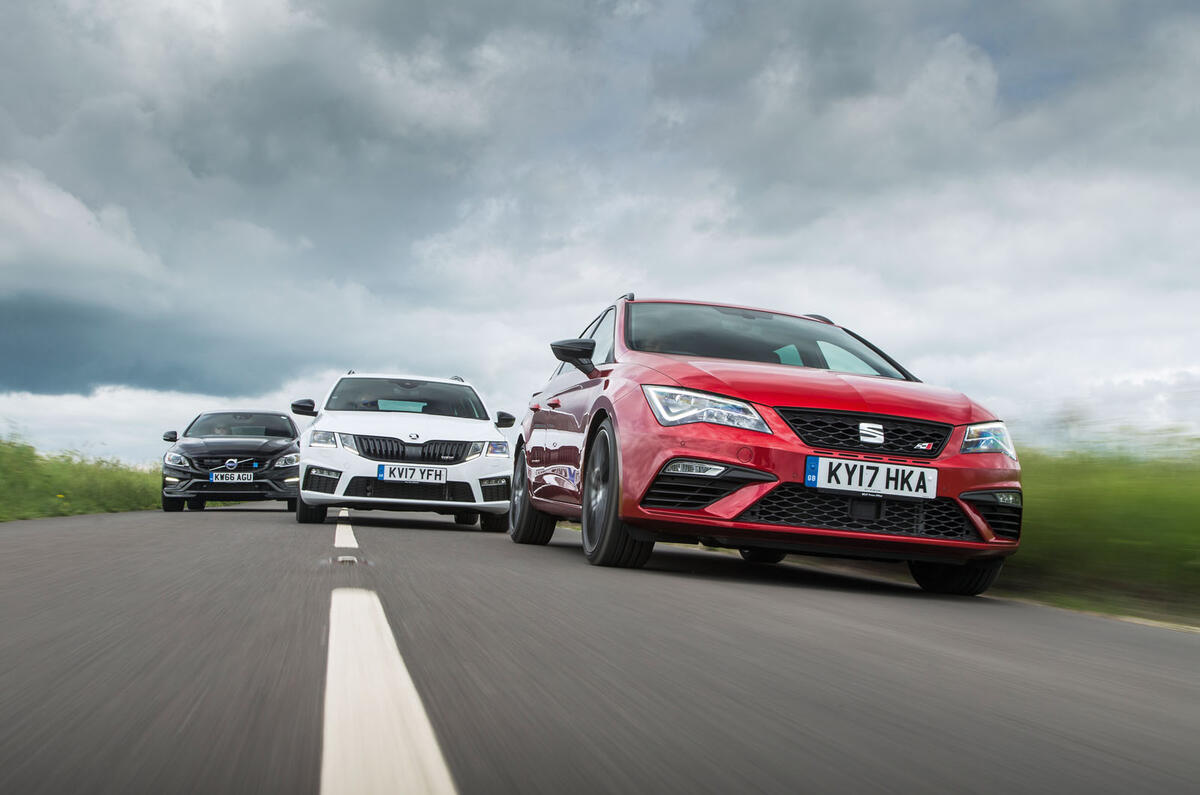
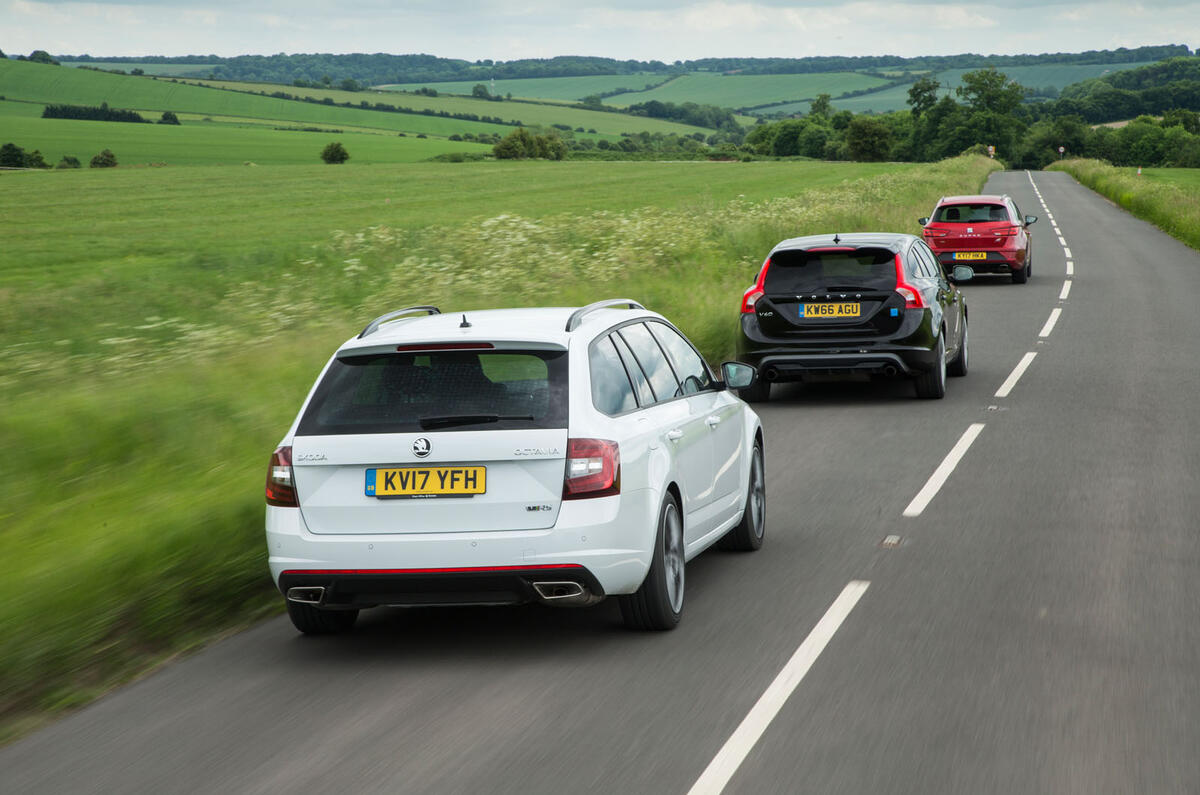
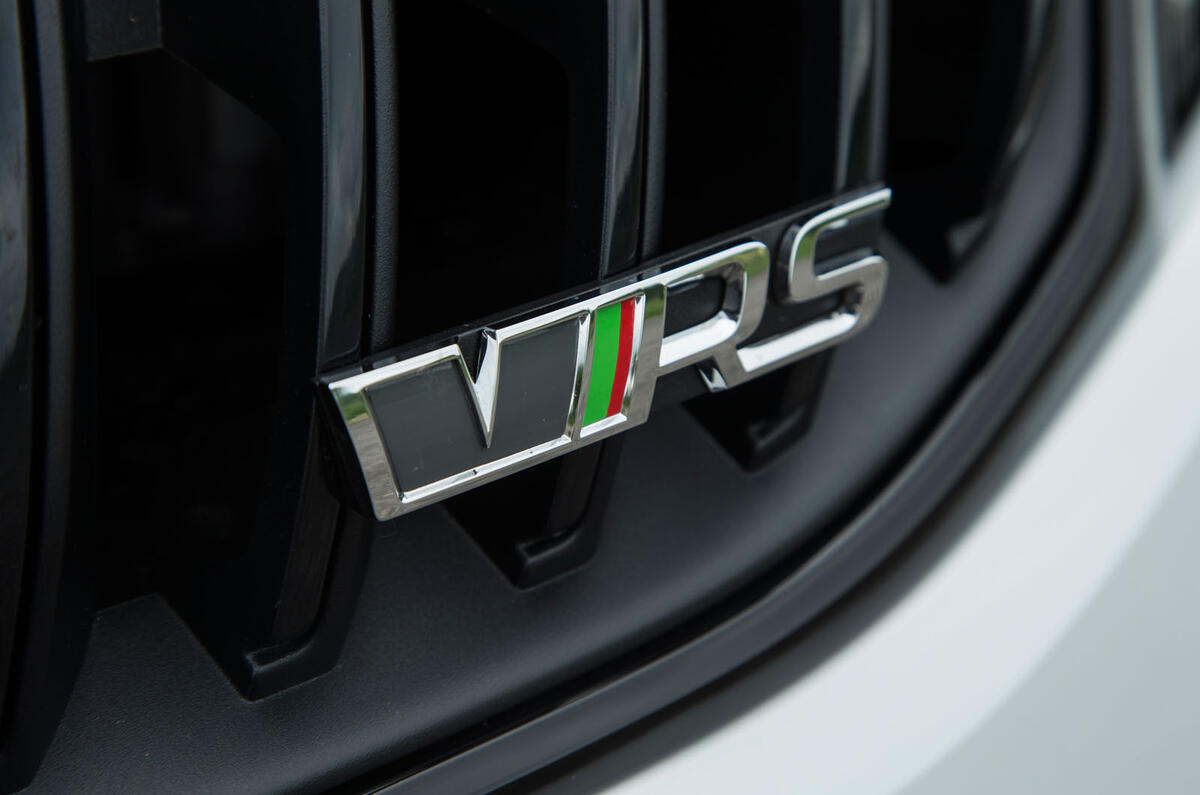
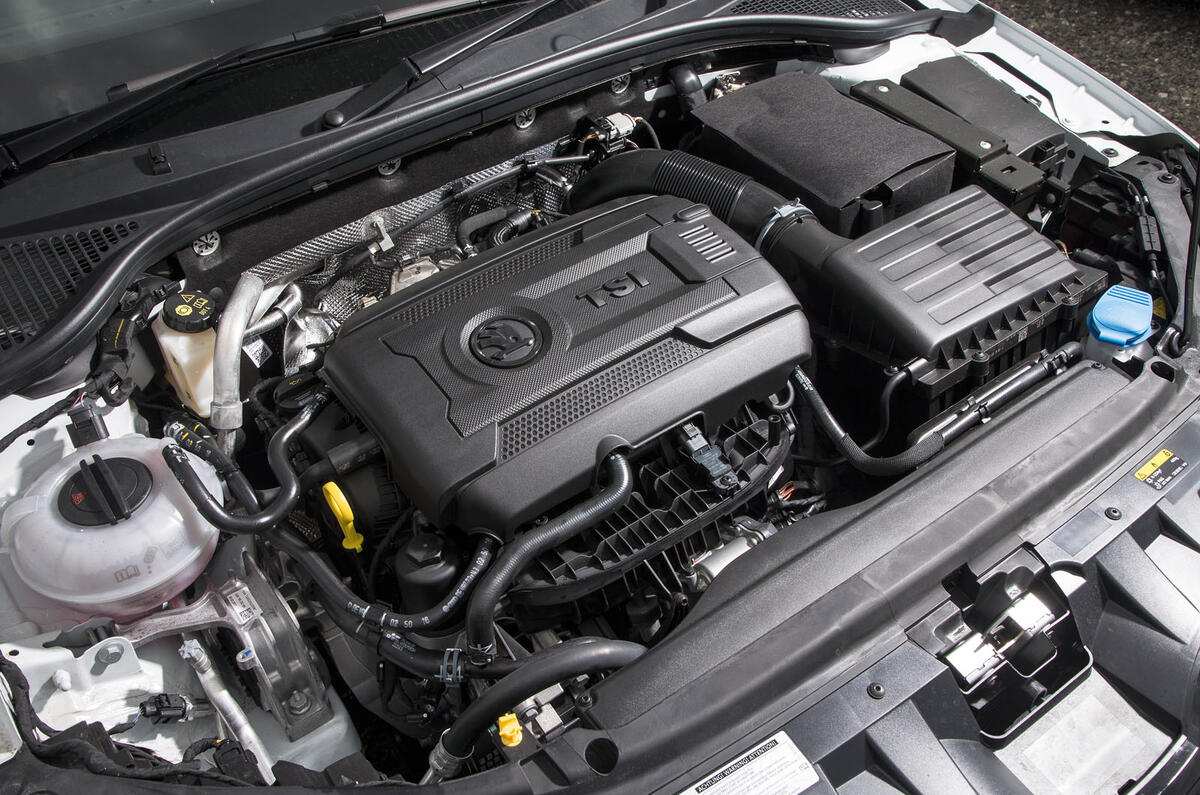
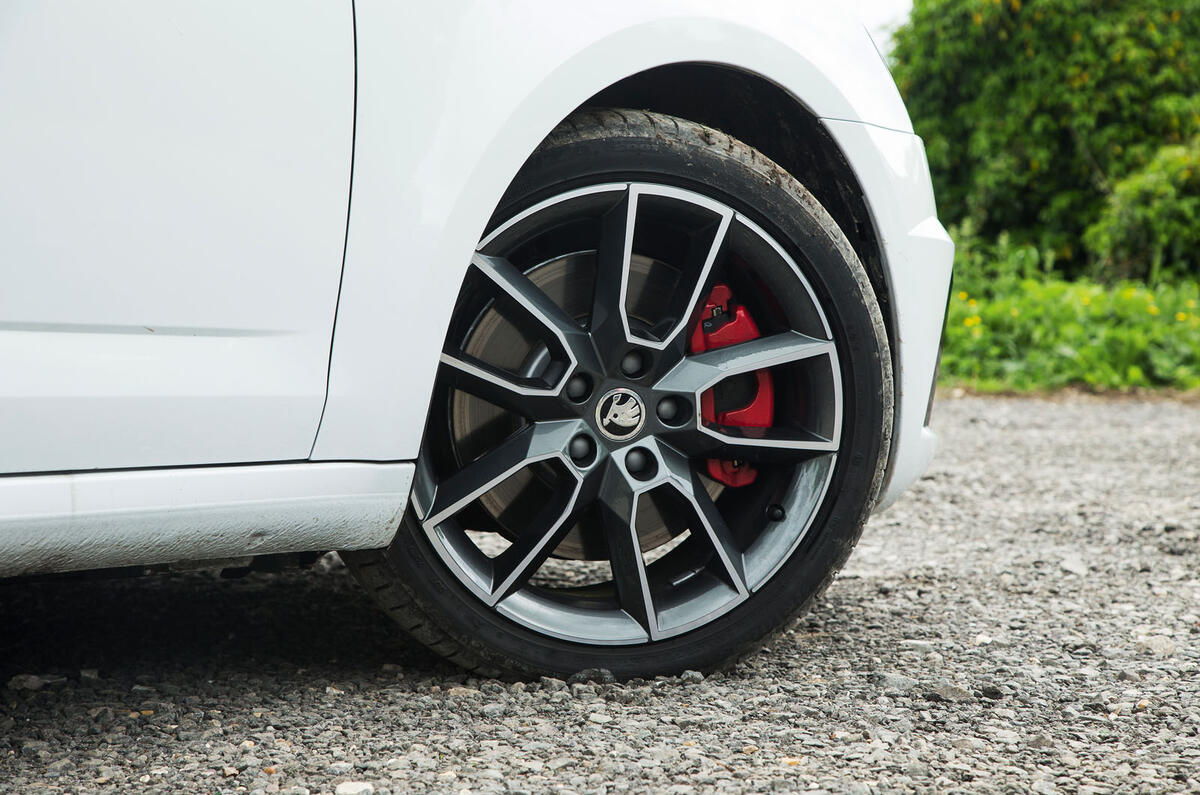
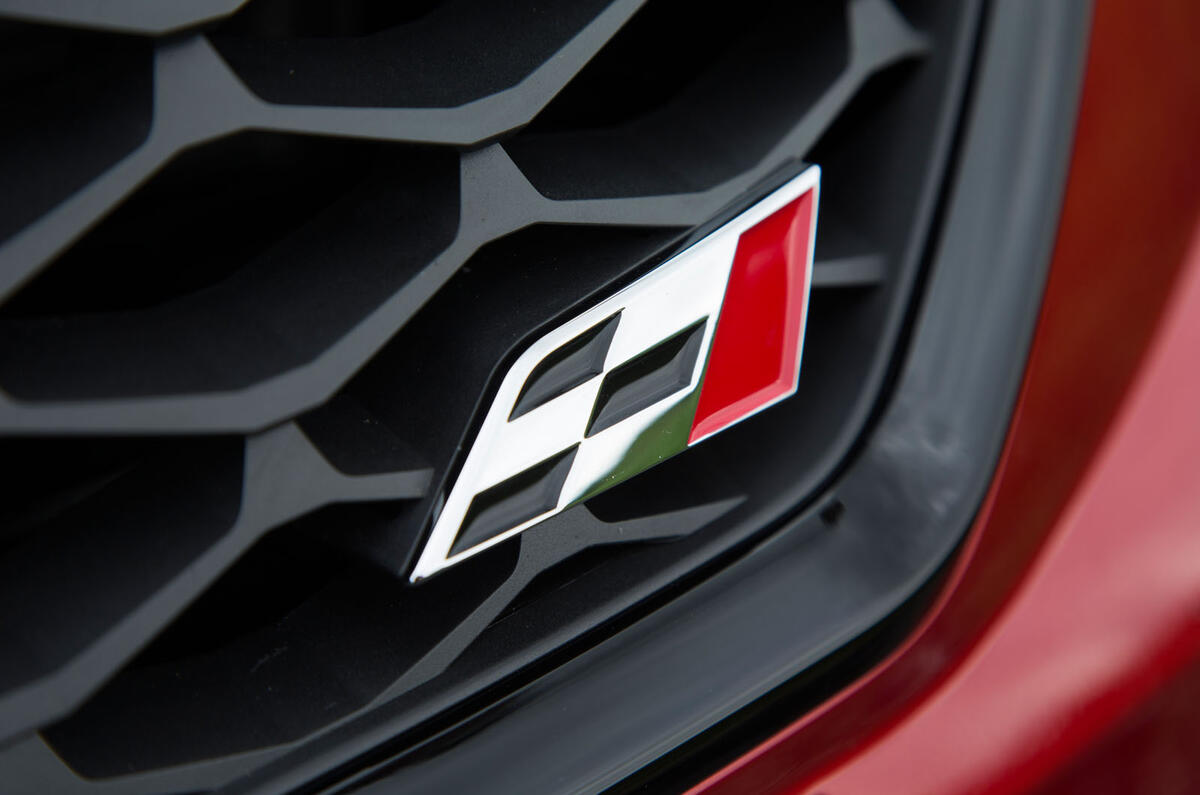
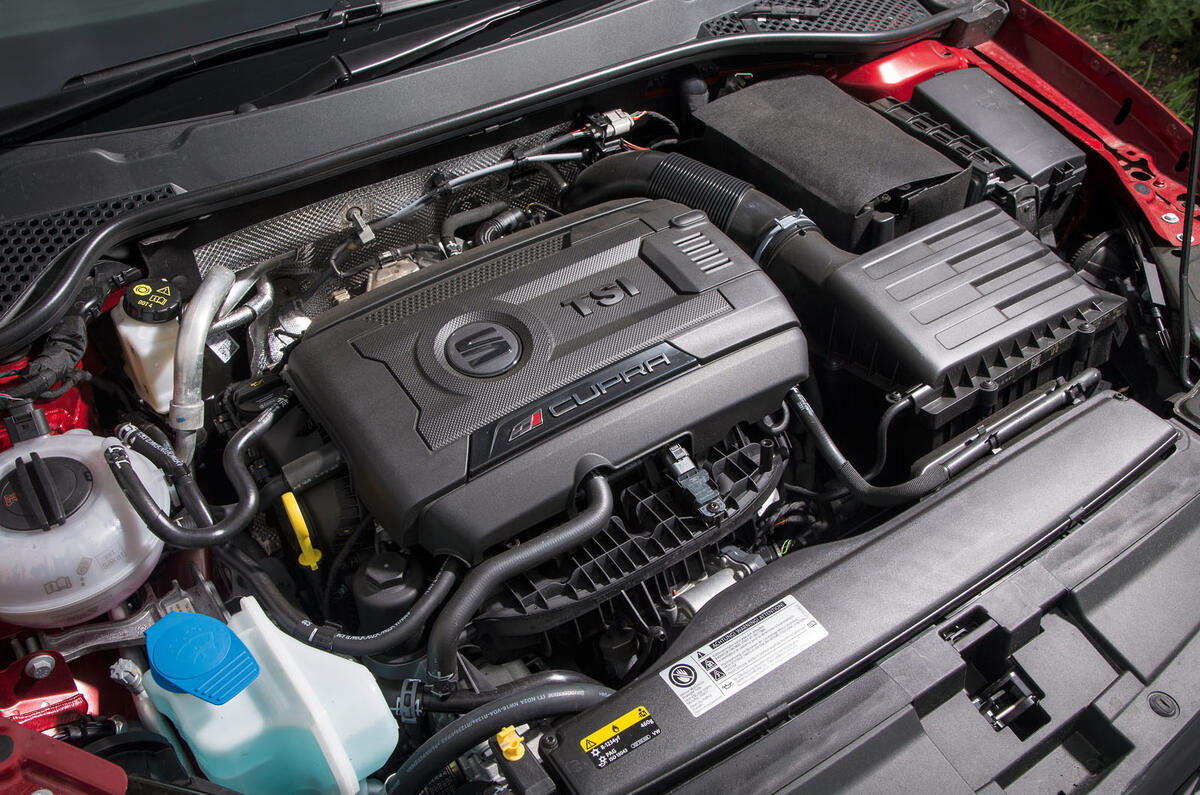


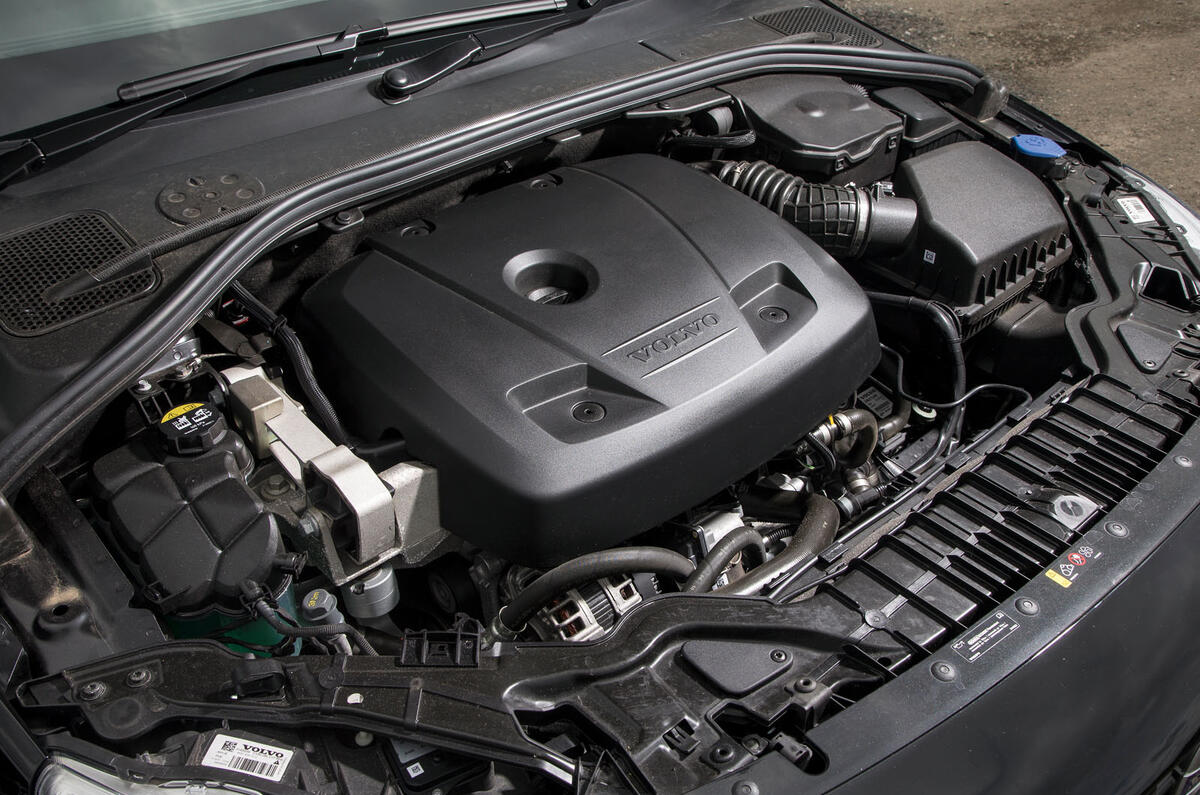
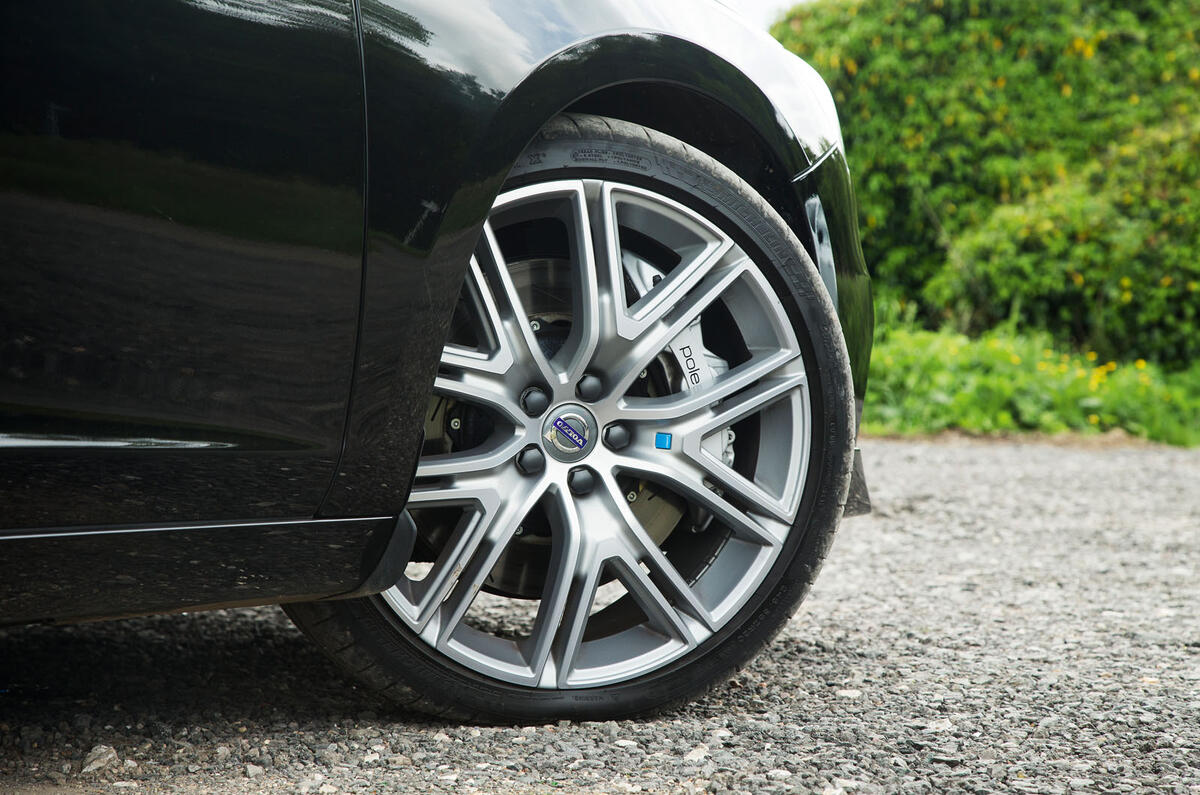
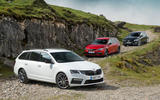



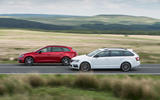
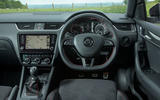
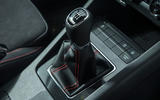
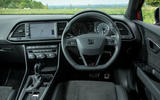
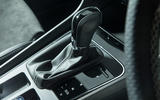
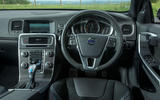
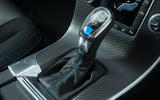


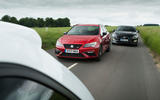

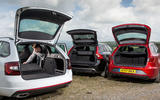



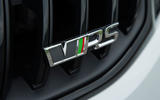
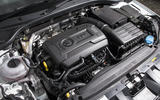
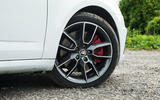

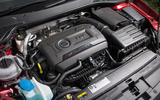
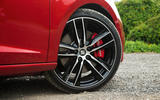

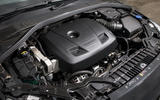



Join the debate
Add your comment
Platform
Let's see...
Let's see...
Skoda = VAG = no chance
Seat = VAG = nope
Volvo = not VAG so wins by default.
This seems like the strangest of group tests. If you are going to widen the criteria, why not include BMW and Mercedes-Benz? I am seriously beginning to wonder about the credibility of Autocar as it seems recently to be part of VAG's marketing department.
...